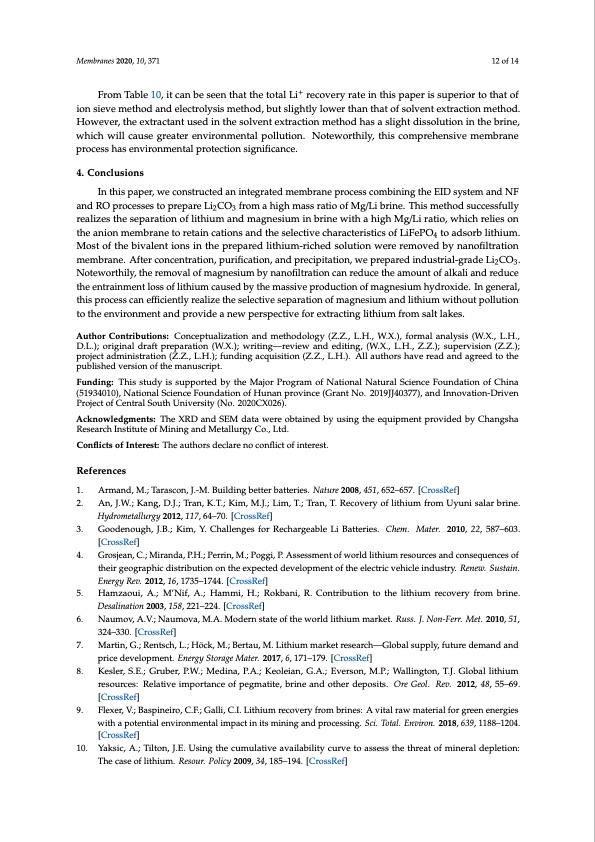
PDF Publication Title:
Text from PDF Page: 012
Membranes 2020, 10, 371 12 of 14 From Table 10, it can be seen that the total Li+ recovery rate in this paper is superior to that of ion sieve method and electrolysis method, but slightly lower than that of solvent extraction method. However, the extractant used in the solvent extraction method has a slight dissolution in the brine, which will cause greater environmental pollution. Noteworthily, this comprehensive membrane process has environmental protection significance. 4. Conclusions In this paper, we constructed an integrated membrane process combining the EID system and NF and RO processes to prepare Li2CO3 from a high mass ratio of Mg/Li brine. This method successfully realizes the separation of lithium and magnesium in brine with a high Mg/Li ratio, which relies on the anion membrane to retain cations and the selective characteristics of LiFePO4 to adsorb lithium. Most of the bivalent ions in the prepared lithium-riched solution were removed by nanofiltration membrane. After concentration, purification, and precipitation, we prepared industrial-grade Li2CO3. Noteworthily, the removal of magnesium by nanofiltration can reduce the amount of alkali and reduce the entrainment loss of lithium caused by the massive production of magnesium hydroxide. In general, this process can efficiently realize the selective separation of magnesium and lithium without pollution to the environment and provide a new perspective for extracting lithium from salt lakes. Author Contributions: Conceptualization and methodology (Z.Z., L.H., W.X.), formal analysis (W.X., L.H., D.L.); original draft preparation (W.X.); writing—review and editing, (W.X., L.H., Z.Z.); supervision (Z.Z.); project administration (Z.Z., L.H.); funding acquisition (Z.Z., L.H.). All authors have read and agreed to the published version of the manuscript. Funding: This study is supported by the Major Program of National Natural Science Foundation of China (51934010), National Science Foundation of Hunan province (Grant No. 2019JJ40377), and Innovation-Driven Project of Central South University (No. 2020CX026). Acknowledgments: The XRD and SEM data were obtained by using the equipment provided by Changsha Research Institute of Mining and Metallurgy Co., Ltd. Conflicts of Interest: The authors declare no conflict of interest. References 1. Armand, M.; Tarascon, J.-M. Building better batteries. Nature 2008, 451, 652–657. [CrossRef] 2. An, J.W.; Kang, D.J.; Tran, K.T.; Kim, M.J.; Lim, T.; Tran, T. Recovery of lithium from Uyuni salar brine. Hydrometallurgy 2012, 117, 64–70. [CrossRef] 3. Goodenough, J.B.; Kim, Y. Challenges for Rechargeable Li Batteries. Chem. Mater. 2010, 22, 587–603. [CrossRef] 4. Grosjean, C.; Miranda, P.H.; Perrin, M.; Poggi, P. Assessment of world lithium resources and consequences of their geographic distribution on the expected development of the electric vehicle industry. Renew. Sustain. Energy Rev. 2012, 16, 1735–1744. [CrossRef] 5. Hamzaoui, A.; M’Nif, A.; Hammi, H.; Rokbani, R. Contribution to the lithium recovery from brine. Desalination 2003, 158, 221–224. [CrossRef] 6. Naumov, A.V.; Naumova, M.A. Modern state of the world lithium market. Russ. J. Non-Ferr. Met. 2010, 51, 324–330. [CrossRef] 7. Martin, G.; Rentsch, L.; Höck, M.; Bertau, M. Lithium market research—Global supply, future demand and price development. Energy Storage Mater. 2017, 6, 171–179. [CrossRef] 8. Kesler, S.E.; Gruber, P.W.; Medina, P.A.; Keoleian, G.A.; Everson, M.P.; Wallington, T.J. Global lithium resources: Relative importance of pegmatite, brine and other deposits. Ore Geol. Rev. 2012, 48, 55–69. [CrossRef] 9. Flexer, V.; Baspineiro, C.F.; Galli, C.I. Lithium recovery from brines: A vital raw material for green energies with a potential environmental impact in its mining and processing. Sci. Total. Environ. 2018, 639, 1188–1204. [CrossRef] 10. Yaksic, A.; Tilton, J.E. Using the cumulative availability curve to assess the threat of mineral depletion: The case of lithium. Resour. Policy 2009, 34, 185–194. [CrossRef]PDF Image | Membrane Process for Preparing Lithium Carbonate

PDF Search Title:
Membrane Process for Preparing Lithium CarbonateOriginal File Name Searched:
membranes-10-00371.pdfDIY PDF Search: Google It | Yahoo | Bing
Product and Development Focus for Infinity Turbine
ORC Waste Heat Turbine and ORC System Build Plans: All turbine plans are $10,000 each. This allows you to build a system and then consider licensing for production after you have completed and tested a unit.Redox Flow Battery Technology: With the advent of the new USA tax credits for producing and selling batteries ($35/kW) we are focussing on a simple flow battery using shipping containers as the modular electrolyte storage units with tax credits up to $140,000 per system. Our main focus is on the salt battery. This battery can be used for both thermal and electrical storage applications. We call it the Cogeneration Battery or Cogen Battery. One project is converting salt (brine) based water conditioners to simultaneously produce power. In addition, there are many opportunities to extract Lithium from brine (salt lakes, groundwater, and producer water).Salt water or brine are huge sources for lithium. Most of the worlds lithium is acquired from a brine source. It's even in seawater in a low concentration. Brine is also a byproduct of huge powerplants, which can now use that as an electrolyte and a huge flow battery (which allows storage at the source).We welcome any business and equipment inquiries, as well as licensing our turbines for manufacturing.| CONTACT TEL: 608-238-6001 Email: greg@infinityturbine.com | RSS | AMP |